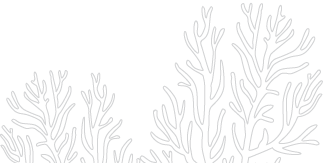At the moment, there are no entries available for display
As a pioneering manufacturer of sustainable fabric solutions, Teejay is committed to operating in harmony with the natural environment. We take pride in responsible stewardship of natural capital, ensuring the well-being of our enterprise, people, and planet.


Our environmental strategy, Abhivarah 2030, prioritises responsible stewardship and management of water, energy, materials, chemicals, air emissions, waste, and biodiversity.
Environmental Strategy: Abhivarah 2030
Abhivarah, meaning “environment”, embodies our commitment to a harmonious coexistence with nature. We believe in working diligently to conserve natural resources and ensuring their sustainability for future generations.
This strategy serves as a roadmap toward a sustainable future, aligning with the Sustainable Development Goals (SDGs), the Science Based Targets initiative (SBTi), and the core principles upheld by the United Nations (UN). As a fabric manufacturer working with leading retail brands to close the loop and drive circularity in the fashion industry, our strategic pillars also align with the 10R concept of circularity, the Circular Economy Model, and are further strengthened by life cycle thinking. The framework emphasises our business imperatives and customer needs, and our corporate responsibility to people and the planet, through three core pillars.
| Responsible Resource Consumption: Doing More with Less | Responsible Discharge: Waste to Wealth | Supporting a Thriving Planet: To Earth with Love |
| Focusing on optimising resource-use and minimising the environmental impact of our operations. | Taking up the challenge of reducing waste, implementing responsible waste management, incorporating circular thinking, and exploring innovative waste-to-value solutions. | Emphasising our commitment to preserving or restoring our planet’s natural ecosystems and biodiversity. |
OUR LANDMARK ENVIRONMENTAL SUSTAINABILITY INITIATIVES
 |
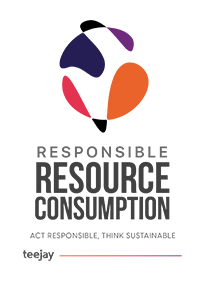 |
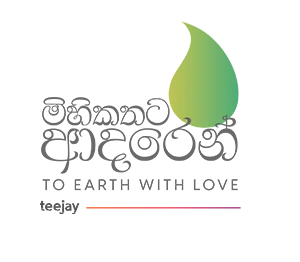 |
| Aligned with the 10R Concept, circular economy principles, and our journey toward fully unlocking the value of all waste streams, we work to minimise waste at the source, practice responsible waste management, and maximise waste that is value-enhanced, re-used, recycled, and diverted from landfills. | Encompasses an integrated approach - spanning emissions reduction, renewable energy investments, energy efficiency measures, and supply chain transformation. | Protecting and enhancing biodiversity, particularly through targeted conservation efforts along the Kelani and Godavari river catchments, which are vital water sources for our operations, employees, and communities. |
| Programmes actively engage waste management partners, educate employees and support staff, and raise awareness amongst the public. We also collaborate with our suppliers and customers to build a more sustainable and circular value chain. | Together, these initiatives are embedding climate responsibility within our business model and supporting the Company’s progress toward achieving a net-zero ambition. | Collaborating with environmental organisations and local communities; our programmes focus on preserving endangered species, developing forest corridors, and promoting ecological balance. |
To advance our environmental sustainability strategy, we facilitate collaboration throughout our supply chain. Annual forums are held for Teejay to communicate and collectively problem-solve with chemical suppliers, yarn suppliers, and waste collectors. We assess the sustainability practices of our partners, ensuring alignment with our compliance requirements, as well as responsible sourcing and environmental stewardship commitments.
Knitting sustainability summit 2024: a catalyst for industry-wide change
In August 2024, Teejay hosted the inaugural Knitting Sustainability Summit; a landmark event that is a core component of our Abhivarah 2030 vision.
The event brought together a diverse range of stakeholders, including industry experts, NGOs, upstream suppliers, and government institutions. It featured insightful discussions from prominent leaders and innovators and set up a powerful platform for knowledge-sharing and collaborative action, toward building a greener future for the textile and apparel sector. Panellists and presenters included experts from Sri Lanka’s premier textile and apparel sector corporations, representatives of regulatory and advisory bodies, industry associations, and esteemed representatives of academia.
The 2024 summit engaged stakeholders to discuss and deliberate on three key industry-specific topics and brought together expertise on a variety of new and emerging topics.
- The future of fashion, technologies, and ESG integration
- Chemical management in the textile industry
- Technology integration for sustainable textile production
Demonstrating our unwavering commitment to environmental responsibility, the Knitting Sustainability Summit was certified as a ZeroCarbon event. A total of 6 tons of CO2 emissions generated by the event were fully offset through the purchase of internationally registered carbon credits. These credits supported a verified project under the Clean Development Mechanism (CDM) in the Asia region, focused on the thermal oxidation of HFC-23 – a potent greenhouse gas. This activity, as an integral part of the CDM initiative, contributes to significant emissions reduction and advances global climate action.
MICROFIBER ELIMINATION PROJECT
As part of Teejay’s commitment to environmental stewardship and innovation, the Company took a pioneering step in 2024/25 to address microfiber pollution, which is an emerging environmental challenge associated with the textile industry. The project saw Teejay become the first textile manufacturer in Sri Lanka to conduct MAP (Microfibre Analysis Protocol) testing with Matter UK with Matter UK, a globally recognised cleantech company focused on preventing microplastic and microfiber pollution at its source.
This strategic project, and continued analysis and development is aligned with Teejay’s broader sustainability goals of promoting circularity and advancing responsible water and waste management. By working with Matter UK, Teejay is actively exploring solutions to eliminate microfibers at the sourcing and manufacturing stages preventing them from becoming pollutants in aquatic ecosystems and addressing the issue before they are released as unrecoverable waste.
Employee engagement is central to our approach, featuring regular awareness sessions, practical training on topics, and promotion of participation in employee-driven initiatives, such as our Nature Clubs. At the heart of these efforts are cross-functional teams, down to plant-level, who meet regularly, track progress diligently, and are an effective task-force for mainstreaming sustainable practices.
Crucially, we also have robust governance structures in place to ensure accountability. Monthly compliance meetings with leadership provide strategic direction, reinforcing senior management's role in driving sustainability. Continuous learning through incident investigations and data-driven decision-making, alongside cross-functional collaboration via Joint Consultative Committee (JCC) meetings, ensures that environmental responsibility is woven into every level of our organisation.
ENSURING DATA ACCURACY AND TRANSPARENCY
We are committed to collecting, verifying, and reporting reliable and accurate information on our sustainability performance. Data is meticulously collected and validated through the Company’s newly upgraded SAP S/4 HANA ERP, and other digital platforms, which seamlessly integrate with a dedicated ESG Sustainability Performance Analyser (ESG-SPA) Tool.
This centralised system enables real-time monitoring of critical metrics, ranging from resource-use, to procurement volumes, material flows, and other traceability data-points. This rigorous approach ensures the highest levels of accuracy and accountability in our sustainability reporting, empowering stakeholders with trustworthy insights into our sustainability performance.
Environmental Targets
We operationalise our commitment to responsible environmental stewardship and track progress against our targets through a carefully structured Environment, Social, and Governance (ESG) framework that guides our sustainability initiatives.
- Achieve zero toxic chemical usage and discharge.
- Reduce water intensity by 50% by 2030, using 2022 as the base year.
- Reduce water intensity by 50%, by 2030.
- 100% waste value-enhancement, by 2030.
- 42% reduction in Scope 1 and 2 emissions by the year 2030, using 2022 as the base year.
- 25% reduction in Scope 3 emissions by 2050, using 2022 as the base year.
- Net-zero carbon emissions, by 2050.
- Plant 1 million trees to restore endangered natural habitats, by 2050.
Environmental Management and Compliance
Our commitment to environmental responsibility is woven into the fabric of our operations, guided by adherence to stringent international benchmarks.
We actively leverage tools like the Higg Facility Environmental Module (Higg FEM) to systematically measure and evaluate our environmental performance. Higg FEM is widely adopted in the apparel and textile industry, and its principles of quantifying sustainability impacts across areas like EMS, energy, water & effluent, waste, air emission and chemical are invaluable in standardising our environmental performance monitoring.
Teejay Group achieved a landmark in environmental stewardship in 2024, showcasing exceptional environmental performance across all facilities. For the first time, all three entities Teejay Lanka, Teejay Prints, and Teejay India scored above 90% on their Higg Facility Environmental Module (FEM) verification, demonstrating significant year-on-year improvements.
Notably, Teejay Lanka attained an outstanding 99%, solidifying its position among the industry’s top global performers. Teejay India made a remarkable leap to 97%, while Teejay Prints achieved an impressive 91%. We utilise Higg FEM as a tool to assess environmental performance across critical metrics, standardise performance and compliance reporting across our facilities; while providing accurate, consistent, and comparable data to our stakeholders.
Our pursuit of excellence in environmental management and other disciplines is reflected in a number of ISO certifications maintained by our facilities. These globally recognised standards demonstrate our systematic approach to mainstreaming quality, prioritising health and safety, improving energy performance, reducing consumption, and lowering greenhouse gas emissions.
| 2024 | 2023 | 2022 | 2021 | 2020 | |
| Teejay Lanka | 99 | 97 | 91 | 90 | 77 |
| Teejay India | 97 | 83 | 79 | 71 | 44 |
| Teejay Prints | 91 | 78 | 68 | 61 | 31 |
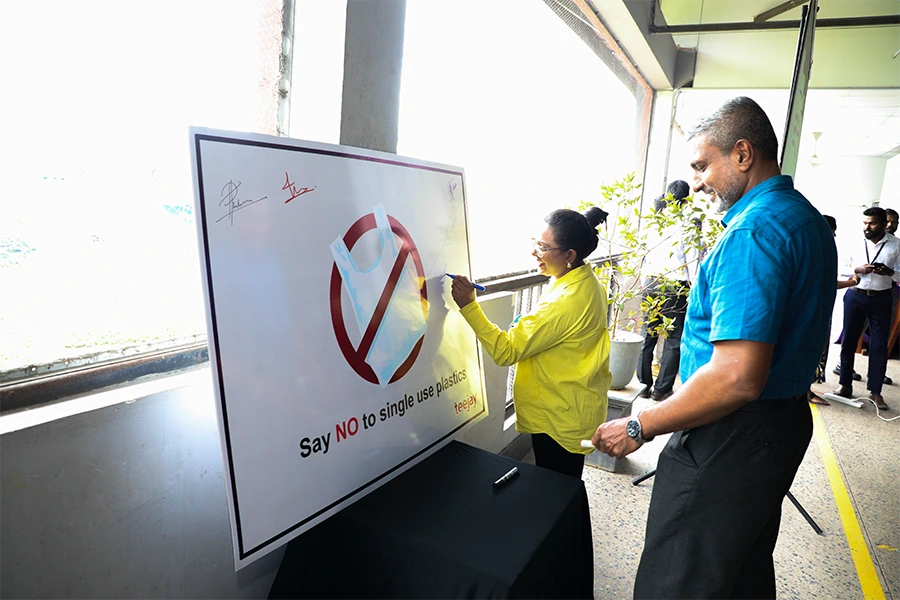
Say no to Single use Plastic initiatives
ISO Standards Implemented
| ISO 14001 – Environmental Management | ISO 14064-1 - GHG Emission Verification and Validation |
ISO 9001 - Quality Management | ISO 45001 – Occupational Health and Safety |
ISO 50001 – Energy Management |
|
| Teejay Lanka |  |
 |
 |
 |
 |
| Teejay India |  |
 |
|||
| Teejay Prints |  |
 |
 |
 |
Materials: Sustainable Sourcing and Circularity
Led by Teejay’s innovation engine, INSCOPE, we continue to collaborate with customers and suppliers to incorporate recycled raw materials our products – including pre and post-consumer recycled materials and up-cycled PET plastic waste. We promote sustainable sourcing practices across our operations, and prioritise organic, regenerative, or renewable raw materials and dyes in our products.
Teejay Lanka PLC was proud to be appointed as the patron company for the Sustainable Supply Chain Working Group organised by the UN Global Compact (UNGC) Sri Lanka. The focus of the working group aligns with our efforts to reinforce sustainable raw material sourcing, mainstream green procurement practices, and minimise environmental impact across our value chain.
The collaboration platform fosters stronger partnerships, inspires timely initiatives, and allows for better information-sharing and impact measurement paving the way for more resilient, sustainable, and future-ready businesses.
Teejay published a case study titled “Innovations in Sustainable Supply Chain Management” at the 2nd International Research Symposium on Sustainable Business (IRSSB 2024), hosted by Edith Cowan University, Sri Lanka. The case study explored Teejay's strategic transformation in chemical management – including our proactive engagement with initiatives like the ZDHC Roadmap to Zero Programme and adoption of Green Chemistry principles.
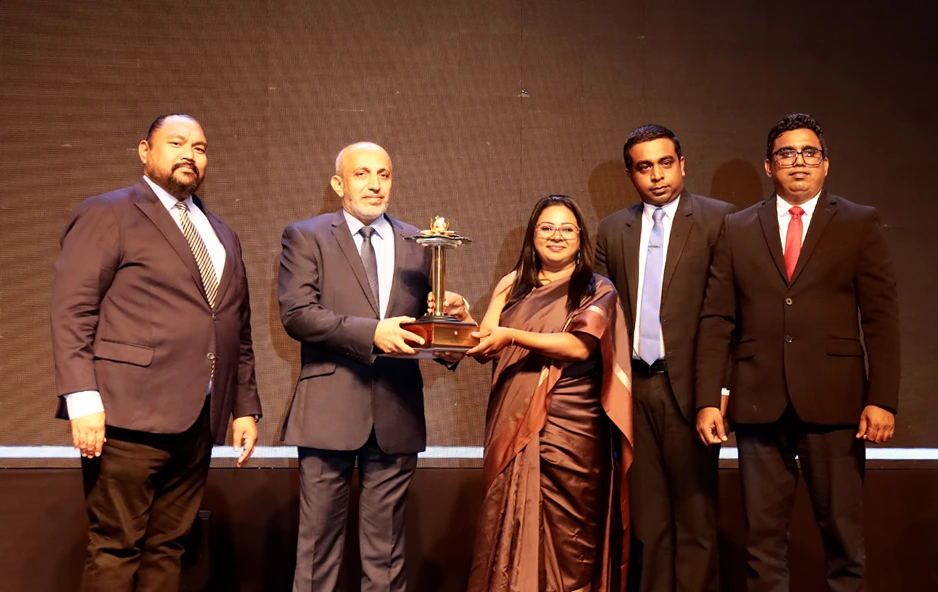
NBEA – Winner, Excellence in Environmental Sustainability

PRIMARY RAW MATERIAL USE
| 2024/25 | 2023/24 | 2022/23 | |
| Yarn (kg) | 23,631,556 | 20,761,900 | 24,555,386 |
| Greige (kg) | 25,061,523 | 20,306,188 | 25,099,809 |
| Dyes (kg) | 1,035,649 | 751,415 | 1,010,946 |
| Chemicals (kg) | 12,404,759 | 10,003,876 | 13,649,716 |
| Auxiliaries (kg) | 3,095,091 | 2,870,054 | 2,915,875 |
| Knitting Needles (units) | 2,726,083 | 2,043,875 | 1,412,471 |
| Packaging Materials (kg) | 398,389 | 1,358,735 | 1,717,419 |
| Consumable Goods and Spares (USD) | 1,376,229 | 1,606,751 | 1,289,335 |
| Prepared for Print (PFP) (kg) | 1,899,576 | 1,728,609 | 2,601,181 |
| Paper (bundles) | 7,952 | 6,469 | 3,000 |
Teejay’s strategic focus on stabilising raw material use while enhancing operational efficiency. The data reveals a balanced approach to sustaining production needs with an emphasis on managing chemical and dye usage alongside core materials like yarn and greige.

Recycled Input Materials
| 2024/25 | 2023/24 | 2022/23 | |
| Volume of recycled input materials used (recycled yarn) (kg) | 1,223,518 | 1,494,664 | 2,571,404 |
| % of recycled input materials used (e.g. recycled yarn) (%) | 5 | 7 | 12 |
The downward trend in recycled input materials reflects broader market dynamics, including reduced customer demand for recycled yarns and limited availability of viable commercial solutions.
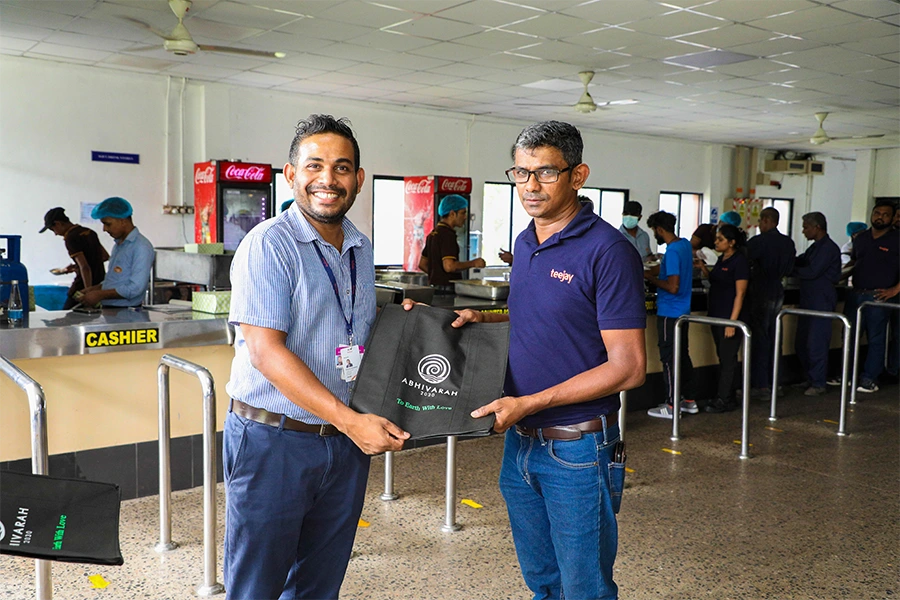
ZERO Plastic initiatives
| GRS | GOTS | OCS | OEKO TEX–100 | RegenAgri | OEKO TEX–STeP | CMiA | BCI | Cotton US Protocol | Eco Labelling Certification | |
| Teejay Lanka |  |
 |
 |
 |
 |
 |
 |
 |
||
| Teejay India |  |
 |
 |
 |
 |
 |
 |
 |
||
| Teejay Prints |  |
 |
 |
 |
HOLISTIC APPROACH TO ADVANCING CIRCULARITY
We actively collaborate with key global customers and strategic supply chain partners to embed circularity principles across our organisation and product lifecycle from material sourcing and product design to chemical use, packaging, and post-consumer waste solutions.
Our focus on Product Sustainability and Circularity extends to our entire product portfolio, driven by a number of initiatives embedded in the Abhivarah 2030 strategy. Our approach embeds circular design principles, prioritises strategic and innovative partnerships, incorporates resource efficiency and waste minimisation, and influences decision-making across all stages of product development from fibre selection to end-of-life considerations.
Circularity Developments in 2024/25
- In 2024/25, we accelerated our focus on material recyclability, biodegradability, and chemical safety. Our product development team worked to expand use of recycled and regenerated fibres, including GRS-certified yarn, and began actively developing mono-material fabric blends that improve recyclability at the garment’s end-of-life stage. We also scaled up product offerings that use responsibly sourced viscose, organic cotton, and recycled polyester.
- We initiated a textile recycling project with key yarn suppliers to support the development of recycled fibre-based fabric collections. The project emphasised mechanical recycling of pre and post-consumer textile waste, with a focus on ensuring recyclability, traceability, and alignment with international standards such as the Global Recycled Standard (GRS). This initiative is part of a broader engagement with yarn manufacturers to co-develop closed-loop circular models
- In terms of packaging material, we launched packaging recycling programmes with selected suppliers, particularly targeting yarn and accessories packaging. These efforts aim to shift toward returnable or recyclable packaging formats, reduce virgin material use, and ensure compatibility with existing recycling streams. Circular packaging pilots have been initiated and scaled based on environmental impact assessments.
- Other continuing innovations included repurposing of used chemical barrels into PVC fabric roll tubes, transforming internal waste into valuable production inputs, while reducing virgin material usage in production.
- Looking to partnerships across the industry and supply chain, Participant of the Sustainable Supply Chain Working Group of UN Global Compact Network Sri Lanka, the 2024 Knitting Summit, and other platforms are enabling greater collaboration across the value chain.
Mainstreaming Circular Thinking
Recognising global regulatory shifts, and developments in the textile industry, we are working to proactively embed upstream and downstream impacts into our product and sustainability strategies. Lifecycle Assessments (LCAs) are utilised when evaluating new innovations and technologies, to identify potential sustainability opportunities and trade-offs early in the development process.
Analytical processes are enhanced by ongoing and new investments in digital infrastructure; including real-time online monitoring systems for water, energy, and emissions, the Group’s SAP S/4 HANA ERP system, and other digital platforms like AREL Orgotex. These tools are providing more accurate data on material flows, production inputs, and environmental impacts, enabling our teams to better evaluate product lifecycles and footprint before commercial scaling.
New products and innovations, including those pioneered by INSCOPE, are assessed not only for performance and feasibility but also their recyclability, composition compatibility, chemical compliance, and end-of-life recovery options.
All innovation pathways are supported by lifecycle thinking, undergo data-backed lifecycle assessments, and involve close engagement with supply chain partners; enabling our Company and the broader supply chain to address industry-level challenges through continuous R&D, incorporation of material science, and innovative sustainable design strategies.
Strategies to address industry challenges
Circular thinking is vital to the long-term sustainability of the textile and fabric industry. However, there remain several technical and structural challenges that limit the scalability of circular models. Gaps in infrastructure for textile waste collection, lack of harmonised recycling standards, and limited commercial-scale technologies for elastane recovery remain significant barriers, while changing market demands and evolving product performance expectations have also hampered progress.
Rising demand for synthetic blends, particularly those incorporating spandex (elastane) proves an ongoing challenge. Spandex is extremely difficult to separate and recycle due to its chemical structure and low melting point.
Industry shifts toward multi-layer textile structures and multi-fiber fabric constructions also presents unique challenges. These advanced fabric architectures pose significant complexity when considering mechanical or chemical recycling, particularly when different materials are laminated, bonded, or finished together.
- In response to these limitations, Teejay has initiated innovation projects to develop multi-layer fabric constructions that meet both performance requirements and circularity criteria. These developments aim to improve recyclability through design-for-disassembly principles and the use of mono-material layers, wherever possible. The R&D team is also exploring re-engineered fabrics that meet customer quality specifications while being easier to recover or repurpose at the end of life.
- Material durability has also emerged as a critical pillar in our circular product strategy, as we place increased emphasis on extending product life through more durable textile solutions. This approach not only supports circularity through reuse and longevity but also helps reduce environmental impact by lowering the frequency of replacement cycles.
Energy: Championing the Energy Transition

Teejay is dedicated to advancing the energy transition and enhancing energy efficiency through cutting-edge technologies and sustainable practices. With a well-defined Energy Management Policy guiding our efforts, and Energy Reduction Utilisation Plans in place, we are working toward clear targets for increased share of renewable energy and reduced energy-use, aligned with the Abhivarah 2030 Strategy.
This comprehensive approach to energy management also involves real-time monitoring systems that track machine-wise energy utilisation, allowing us to swiftly detect and address any abnormal peaks in energy consumption. This proactive approach not only improves operational efficiency but also plays a crucial role in reducing consumption and resulting carbon emissions. Our commitment to effective energy management is backed by ISO 50001 certification, ensuring compliance with global energy performance standards.
we saw total energy consumption increase marginally during the year, aligned with growth in production and sales volumes.
Successful progression of our renewable energy scale-up plans resulted in a net increase in the share of renewables in our energy mix – which now stands at 14%. Steady increase in biomass utilisation, and new iREC purchases contributed to these gains: as we closed the year with 19% of total electricity consumption sourced from IREC-certified renewable power. During the year under review, we also initiated projects for expansion of critical solar infrastructure, with an investment of LKR 2.7 Mn., which will add 7MW rooftop solar capacity to our energy footprint within the next years.
Our ongoing efforts to phase out use of fossil-fuels, led to an overall reduction in total energy from fossil fuels despite the increase in overall Group energy consumption. An exemplar has been the reduction in diesel usage by approximately 45% YoY. Teejay made an important investment of LKR 2.6 Mn. in coal phaseout plans during the year. We also commissioned the infrastructure for a Pipeline Natural Gas (PNG) unit, which would reduce reliance on higher-emission fuels. Coupled with plans in place to gradually replace Heavy Fuel Oil (HFO) with cleaner alternatives, we expect these future-looking investments to significantly reduce Teejay’s dependence on fossil-fuels and transform our energy mix in the years ahead. Looking forward, we have plans in place for a number of energy efficiency improvements, including installation of high-efficiency 6 million calorie thermic boilers with improved thermal efficiency.
Our ongoing efforts to phase out use of fossil-fuels, led to an overall reduction in total energy from fossil fuels despite the increase in overall Group energy consumption. An exemplar has been the reduction in diesel usage by approximately 45% YoY. Teejay made an important investment of LKR 2.6 Mn. in coal phaseout plans during the year. We also commissioned the infrastructure for a Pipeline Natural Gas (PNG) unit, which would reduce reliance on higher-emission fuels. Coupled with plans in place to gradually replace Heavy Fuel Oil (HFO) with cleaner alternatives, we expect these future-looking investments to significantly reduce Teejay’s dependence on fossil-fuels and transform our energy mix in the years ahead. Looking forward, we have plans in place for a number of energy efficiency improvements, including installation of high-efficiency 6 million calorie thermic boilers with improved thermal efficiency.

Energy management at Teejay is governed by a robust Energy Management System certified to ISO 50001:2018, enabling detailed tracking, analysis, and optimisation of energy consumption. A real-time energy monitoring platform facilitates the management of Significant Energy Users (SEUs) on a department-wise basis. Key energy optimisation initiatives implemented in 2024/25 include:
- Automation of chiller systems to dynamically adjust cooling based on real-time demand, complemented by the installation of Variable Frequency Drives (VFDs) on HVAC systems, ensuring energy use aligns with actual needs.
- Upgrades to production machinery, replacing high-liquor ratio dyeing machines with low-liquor alternatives, reducing energy and water consumption per cycle. Boiler system enhancements included burner modifications, advanced insulation, and condensate recovery to reduce thermal energy demand.
- Plant-wide compressed air optimisation project, which centralised air distribution, reduced nozzle sizes, and repaired leaks. The project resulted in a 30% reduction in compressed air usage, cutting daily energy consumption by approximately 134 kWh and 739 CFM, and allowing operation with only four compressors instead of seven.
- Introduction of sensor-based automation in the finishing section to ensure compressed air is used only during active fabric uncurling, eliminating around 16 kWh of wasted energy per idle hour across nine stenters.
- Optimisation of cooling systems in the new knitting area, with shutdown during non-productive hours. This shift saves an estimated 1,688 kWh daily.
Launch of Fast React: a digital tool that optimises production scheduling to better align energy use with operational demand.
Emissions: Decarbonising our Operations

Teejay has committed to decarbonising our operations through concrete emission-reduction commitments aligned with the Science-Based Targets initiative (SBTi). These targets are embedded within the Abhivarah 2030 strategy, which ensures climate risks are systematically evaluated and addressed.
Working toward these targets, we have implemented advanced emission control devices across our facilities and diligently monitor emission levels through real-time systems. We also methodically monitor emission of ozone-depleting substances (ODS) as defined by the Montreal Protocol. The Group follows a rigorous programme for monitoring nitrogen oxides (NOx) and sulphur oxides (SOx) emissions, ensuring they consistently comply with regulatory tolerance levels. Annual stack emissions testing is conducted by accredited third-party laboratories to verify adherence to all relevant air quality regulations, including NOx, SOx, and other parameters.
Our commitment to climate action
Teejay has formally committed to the Science-Based Targets initiative (SBTi), setting the following near-term targets that have been officially approved by the SBTi and are fully aligned with the 1.5°C pathway outlined in the Paris Agreement. These targets are integral to Teejay’s Abhivarah 2030 strategy and guide the Group’s transition to low-carbon operations and achieving Net Zero by 2050.- 42% reduction in Scope 1 and 2 emissions by 2030 (using 2022 as the base year)
- 25% reduction in Scope 3 emissions by 2030 (using 2022 as the base year)
We have adopted a holistic and data-driven approach to climate risk management, with a strong focus on Scope 3 emissions, which constitute the largest share of the Group’s overall carbon footprint. All 15 Scope 3 categories defined by the GHG Protocol are considered, with focused action on the 11 categories most relevant to Teejay’s operations.
We carry out detailed Scope 3 calculations in collaboration with RESET CARBON - Hong Kong, and ensure third-party verification in accordance with ISO 14064-1:2018, which is conducted by the National Cleaner Production Centre (NCPC) Sri Lanka. This approach ensures transparency, credibility, and continuous improvement in its climate reporting and mitigation efforts.
Our recent patronage of the UNGC Sustainable Supply Chains working group, and active membership in the UNGC Climate Taskforce, will allow Teejay to play a pivotal role in advancing sustainable practices not only within our own operations, but also across the industry.

| SBTI Categories | Ton Co2 eq |
| Scope 1 | 70,281.58 |
| Scope 2 | 37,814.30 |
| Scope 3 | 568,570.49 |
| Cat 1 – Purchase Goods and Services | 258,937.47 |
| Cat 2 – Capital Goods | 1,276.25 |
| Cat 3 – Fuel and Energy-Related Activities (not included in Scope 1 or 2) | 27,923.43 |
| Cat 4 – Upstream Transportation and Distribution | 30,543.16 |
| Cat 5 – Waste Generated in Operations | 8,308.65 |
| Cat 6 – Business Travel | 133.05 |
| Cat 7 – Employee Commuting | 2,625.61 |
| Cat 9 – Downstream Transportation and Distribution | 26,588.00 |
| Cat 10 – Processing of Sold Products | 186,587.72 |
| Cat 12 – End-of-Life Treatment of Sold Products | 25,647.16 |
| Total | 676,666.38 |
Decarbonisation strategy updates 2024/25
Teejay implements a comprehensive decarbonisation and energy transition plan, which includes renewable energy integration, fuel switching to lower-emission alternatives, and system-wide energy efficiency enhancements. Significant milestones during the reporting period include:- Commissioning of a Pipe Natural Gas (PNG) unit, reducing reliance on higher-emission fuels.
- Launch of a coal phase-out project valued at USD 2.645 Mn., coupled with the gradual replacement of Heavy Fuel Oil (HFO) with cleaner alternatives, thereby improving environmental and operational performance.
- Investment of USD 2.7 Mn. in a 7 MW rooftop solar project, significantly lowering Scope 2 emissions and dependence on grid electricity.
- Procurement of approximately 8,000 MWh of IREC-certified renewable electricity from mini-hydro sources, diversifying the clean energy portfolio.
Water: Stewardship of Water Resources

We recognise water as a critical resource for our manufacturing operations, and we are committed to the conservation of the water sources we utilise. The Company takes a multi-pronged approach to minimise water usage and ensure responsible treatment of effluent. We actively collaborate with industry partners and other institutions to explore innovative solutions for water-use reduction and effective effluent treatment management. We apply a dynamic production mix in comparison to the previous years.
Feasibility study is ongoing for water treatment and salt recovery for water recycling and reduction of water consumption.
| Water intensity | 2024/25 | 2023/24 | 2022/23 |
| Water consumption per unit of revenue (Litres) | 0.028 | 0.038 | 0.041 |
Our approach to water stewardship
Teejay adopts a proactive and science-informed approach to water stewardship as a key component of the Abhivarah 2030 sustainability strategy. With a clear target to reduce water intensity by 50% by 2030, the Company implements robust, data-driven measures to enhance water use efficiency, minimise freshwater dependence, and ensure compliance with environmental standards across all facilities.
Water plays a critical role in our manufacturing processes, particularly in dyeing - which accounts for the highest portion of water consumption. In addition to dyeing, water is also consumed in filter backwashing, effluent treatment, and domestic facilities such as canteens and wash rooms.
To ensure responsible water stewardship, Teejay sources water from non-water stressed regions, such as the Kelani River in Sri Lanka and regulated supplies from the Godavari River in India, aligning with national water management priorities. The company further applies water-efficient technologies and practices tailored to the unique context of each facility, including water reuse projects, rainwater harvesting systems, and domestic water optimisation initiatives.
Identifying water-related impacts and informing our water stewardship strategy
To optimise use, Teejay partnered with the National Cleaner Production Centre (NCPC) Sri Lanka to conduct a comprehensive water audit. The audit assessed all major water use points across facilities to identify high-consumption areas and potential efficiency improvements. The assessment scope covered manufacturing processes, utilities, and domestic water use, aligned with the company’s 2030 sustainability roadmap timeframe.
Target-setting and progress monitoring
Teejay’s water-related goals are included within the Abhivarah 2030 sustainability strategy. The goal-setting process factors local water stress conditions of each operational site in Sri Lanka and India, and ensures alignment with relevant public policy and regulatory frameworks governing sustainable water management. Recognising the complexity of water-use, we set separate, specific, targets for blue water consumption, rainwater harvesting, water reuse, recycling, and domestic water-use, as tracked under the Higg Facility Environmental Module (FEM).
Water consumption and discharge data are continuously monitored via real-time tracking systems and reported through the Higg Facility Environmental Module (FEM), providing accurate, accountable, and ongoing visibility to internal and external stakeholders.
Collaboration for compliance
We actively engage suppliers and partners to promote sustainable water use across the value chain; encouraging circular water practices and water-efficient technologies within the supply chain, promoting responsible water stewardship among partners to reduce collective water-related impacts, supporting collaboration and knowledge sharing on best practices for water conservation and management, and maintaining continuous collaboration with local authorities and industrial park operators to ensure responsible water management and compliance with regulatory requirements.
Input: Responsible Water-Use
In Sri Lanka, all water requirements for Teejay Lanka and Teejay Prints are fulfilled through third-party suppliers operating within the Board of Investment of Sri Lanka (BOI) Seethawaka Export Processing Zone (SEPZ). These suppliers source from non-water stressed regions, including the Kelani River, ensuring that Teejay’s operations remain aligned with national priorities for sustainable water use and responsible resource management.
In India, water requirements at Teejay India are fully supplied by Adhistan Industrial Park, which sources from the Godavari River, under regulated access and supply agreements.
We continue to explore rainwater harvesting opportunities and have completed rainwater yield assessments of our facility rooftops. Future integration of harvested rainwater into operations will further contribute to long-term water conservation goals.
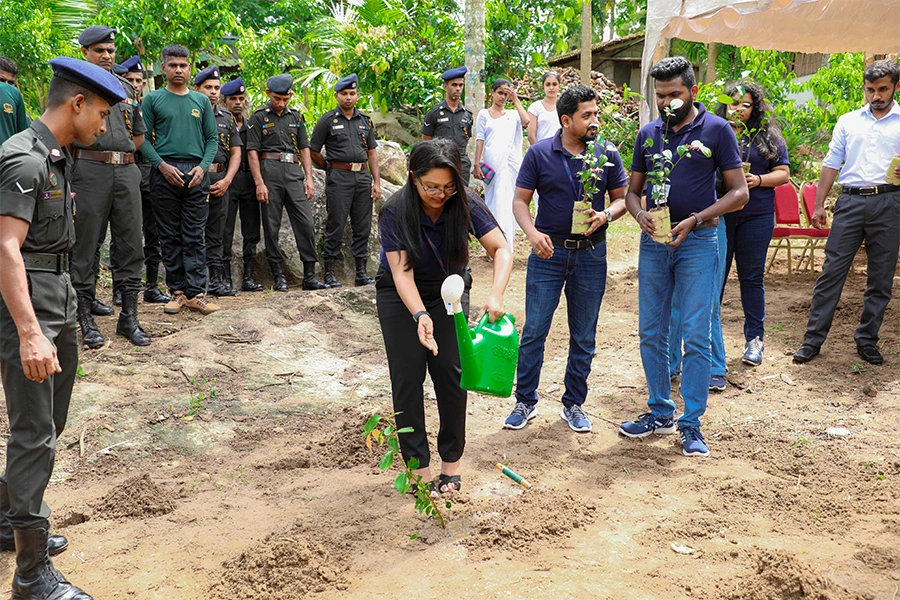
Water withdrawal in 2024/25 increased by 19% YoY, reflecting expansion in production volumes experienced during the year. All water withdrawal reported, is considered to be from freshwater sources (less than 1,000TDS), and from non-water-stressed areas.
| (m3) | 2024/25 | 2023/24 | 2022/23 | 2021/22 |
| TJL | 1,390,250 | 1,224,238 | 1,178,162 | 1,275,254 |
| TJP | 160,245 | 152,044 | 149,681 | 176,802 |
| TJI | 1,221,773 | 950,595 | 1,005,653 | 810,675 |
| Group water withdrawal | 2,772,268 | 2,326,877 | 2,333,496 | 2,262,731 |
Increased water-use during the year was partly offset by a number of water-saving and water-use efficiency initiatives carried out based on findings of the water audit. New and ongoing initiatives include:
- Water reuse programmes such as recycling treated backwash water and recovering machine-cooling water.
- Leak prevention and repair programmes to minimise water-loss.
- Preliminary investigations to install rainwater harvesting systems.
In addition, our facilities carry out ongoing community responsibility initiatives, such as tree planting campaigns, aimed at enhancing ecosystem health and sustainability of key water catchment areas; including the Kelani and Godavari river-basins, which are vital to Teejay’s operations.

Output: Stringent Standards for Effluent Discharge
Teejay employs a robust approach to wastewater management across all facilities to ensure responsible and compliant effluent discharge. Our wastewater management practices are compliant with national regulations and guidelines in our areas of operation.
We also benchmark performance against internally developed water quality standards and guidelines that are aligned with international best practices and sector-specific requirements. Teejay is fully committed to the Zero Discharge of Hazardous Chemicals (ZDHC) framework, integrating the ZDHC Chemical Management System (CMS) and Technical Industry Guidance (TIG) into our chemical and wastewater management practices. These standards are designed to ensure that effluent quality meets or exceeds environmental safety thresholds, even in the absence of local mandates.
Advanced monitoring systems are installed at Wastewater Treatment Plants (WTP) and Effluent Treatment Plants (ETP), providing real-time data on critical parameters such as flow rates, volume, and tank levels. Plans are underway to expand this monitoring to include additional quality indicators like pH, temperature, colour, Chemical Oxygen Demand (COD), Total Dissolved Solids (TDS), and Total Suspended Solids (TSS), guaranteeing thorough oversight of the entire treatment process.
Regular monitoring is performed hourly by technicians and periodically by an internal IREA laboratory, supplemented by monthly verification from third-party accredited labs. Monthly third-party wastewater testing and biannual ZDHC-specific testing are conducted to ensure that hazardous chemical discharge is minimised and kept within strict regulatory limits. This commitment extends across all production facilities, with zero violations reported during the review period.
Effluent from industrial processes at Teejay Lanka and Teejay Prints is managed via a two-stage treatment process. Primary treatment onsite through dedicated Effluent Treatment Plants (ETPs). This pre-treated effluent is then transferred to the secondary biological treatment system operated by the Central Treatment Plant (CTP) of the Board of Investment (BOI) within the Seethawaka Export Processing Zone (SEPZ).
At Teejay India, located within the Adhistan Industrial Park, Visakhapatnam, no primary treatment is conducted onsite. Instead, all industrial effluent is directly routed to the Common Effluent Treatment Plant (CETP) managed by the park operator, ensuring that wastewater is treated in line with Indian environmental compliance requirements through centralised facilities.
| (m3) | 2024/25 | 2023/24 | 2021/22 | 2022/23 |
| TJL | 1,234,528 | 1,088,460 | 1,046,120 | 1,128,553 |
| TJP | 128,276 | 121,635 | 128,124 | 141,441 |
| TJI | 1,160,684 | 903,066 | 1,038,830 | 759,775 |
| Group water discharge | 2,523,488 | 2,113,161 | 2,213,074 | 2,029,769 |
Chemicals: Responsible Management
Teejay’s reputation as an industry leader in environmental stewardship, is supported by strong transparency and traceability in all chemical-related activities. We are recognised globally for exemplary chemical management practices. Teejay is a ZDHC signatory supplier, featured on the Detox Live platform that monitors global chemical compliance, and as of 2024/25 – we are also a Bluesign system partner.
The year 2024/25 saw Teejay becoming an official bluesign® system partner. This exemplary global certification demonstrates our successful integration of sustainable and environmentally responsible practices across the entire production process. This is the culmination of a multi-year process that involved comprehensive evaluation of Teejay’s chemical inputs, production processes, and supply chain controls, showcasing the Company’s dedication to responsible manufacturing.

A major achievement in 2024/25 was maintaining 100% ZDHC MRSL conformance across the group; showcasing our strong commitment to responsible chemical management and supply chain transparency. Teejay Lanka notably improved its performance from 95% to 99.6% during the financial year, while Teejay Prints maintained 100% compliance and Teejay India sustained compliance over 95%.
| ZDHC Supplier to Zero – Progressive Level Certification |
ZDHC Verified InCheck Level 1 Certification |
bluesign® System Partnership |
|
| Teejay Lanka |  |
 |
|
| Teejay India |  |
||
| Teejay Prints |  |
- All three of manufacturing facilities – Teejay Lanka PLC, Teejay Lanka Prints (Pvt) Ltd, and Teejay India Private Ltd. – achieved ZDHC Progressive Level Certification during the year. Additionally, we also completed ZDHC verified InCheck certification for all three entities.
- Additionally, achievement of bluesign® certification and continued use of ZDHC tools further reflect our progress in aligning operations with global best practices.
- We also participated in the ZDHC Roadmap to Zero Programme’s South Asia Regional Conference in 2024. Teejay’s Manager – Group Sustainability, Ishara Perera, represented Teejay and shared insights on the Company’s transformation journey titled “Achieving Business Sustainability through the ZDHC Roadmap to Zero Programme.”
- At the Green Industry Symposium 2024, Teejay showcased its leadership in sustainable innovation by publishing two case studies under the themes of “Green Digital & Information Technologies and Sound Chemical Management”.
- Looking ahead, we are looking to invest in zero liquid discharge (ZLD) infrastructure, and planned enhancements to our digital platforms for sustainability performance monitoring, all of which would further strengthen our chemical management processes.
OUR CHEMICAL MANAGEMENT PROCESS
Responsible Chemical Management is part of our Abhivarah-2030 strategy, to ensure environmental protection, worker safety, and regulatory compliance. Our chemical management process covers our entire production lifecycle: from input, throughout all industrial processes, and concluding with management of outputs. It includes standards and processes for procurement, storage, handling, disposal, and monitoring, throughout our operations; constituting a comprehensive system that guarantees safety, efficiency, transparency, and traceability at every stage. The entire chemical management system is integrated with, and controlled through, the Group’s Enterprise Resource Planning (ERP) system and warehouse management protocols.
To safeguard customers and end-users, we enforce a Restricted Substance List (RSL) to exclude prohibited substances from products. Comprehensive product assessments and rigorous chemical residue testing are integrated into the production cycle to guarantee compliance with both customer-specific and regulatory chemical safety standards. The Company maintained a flawless compliance record during the reporting year, with regard to the health and safety impacts of our products and services.
Our maintenance of ZDHC standards reflects this compliance with the ZDHC Manufacturing Restricted Substances List (MRSL) and wastewater guidelines, which are critical components in minimising the use and discharge of hazardous chemicals across the production process. ZDHC verified InCheck certification ensures our chemical inventory is aligned with the ZDHC MRSL and that transparent reporting and traceability mechanisms are in place.
In addition, we work to continuously assess and eliminate potentially hazardous substances - replacing them with safer, sustainable alternatives while adhering to local regulations and global standards to meet customer compliance requirements. Through green procurement policies, the company sources only environmentally friendly chemicals, collaborates with upstream and downstream suppliers to enhance sustainable practices, and ensures all purchases comply with stringent industry regulations.
Waste: Reducing Waste and Unlocking Value

As part of our long-term sustainability vision, Abhivarah 2030, we have set ourselves a very ambitious target of achieving 100% waste value enhancement by 2030, through incorporation of circular economy principles and organisation-wide focus on transforming waste into valuable resources.
We operating in full compliance with the local regulations, with regard to waste management, in Sri Lanka and India, and actively work to minimise waste generation at source while also ensuring environmentally responsible disposal methods. To ensure proper waste management, we conduct comprehensive auditing of waste vendors, monitoring waste disposal until final processing by authorised disposers.
Our waste reduction efforts are embedded within our operational practices through detailed waste mapping at the department level, supported by department-wise and individual KPIs dedicated to continuous waste reduction. This systematic approach enables effective tracking, management, and improvement of waste performance across all major business functions.
Additionally, we actively engage with local communities to enhance compliance with waste management regulations and improve sustainable waste collection standards. To further strengthen these efforts, we conduct regular waste collectors’ forums to boost engagement and facilitate knowledge sharing.
Teejay, in collaboration with Zero Trash and the Seethawaka Urban Council, launched the "Waste to Wealth" programme an initiative designed to recognise and empower unsung heroes involved in industrial and community waste management. The programme extended to janitorial staff from municipal councils and cleaning staff from a number of organisations who contribute to keeping the community clean and hygienic. First launched in Avissawella, targeting janitorial workers under the Seethawaka Urban Council, plans are in place to expand reach to the whole country.
Programme participants were engaged in practical awareness sessions to improve their knowledge of effective waste segregation and environmental hygiene. A field visit was organised to the Moratuwa Municipal Council, to witness successful waste management practices firsthand. In addition to knowledge-sharing, Teejay extended its support by distributing dry ration packs to support janitorial and cleaning staff.
Due to improved waste management processes and new initiatives for recycling, we successfully increased the volume of non-hazardous waste diverted from disposal by around 13% YoY. This enabled us to achieve a total 97% of all non-hazardous waste value-enhanced, through recycling or re-use. Non-hazardous waste incineration was reduced by 43% year-over-year, with a shift toward more environmentally preferable disposal methods and ensured that we maintained zero-landfilling status during the year.
In 2024/25, we more than doubled the volume of hazardous waste diverted from disposal. However, around 97% continues to be directed to disposal as per industry standards, regulatory requirements, and waste management best practices. New and ongoing projects for waste management include:
- Fabric recycling projects, continued improvements to fabric segregation to maximise recycling and resource recovery, and a number of other landmark circular economy in collaboration with innovative partner organisations. These and other developments are highlighted under Circularity Developments in 2024/25.
Investment of approximately USD 62,400 to upgrade hazardous and non-hazardous waste storage facilities at Teejay Lanka, in line with regulatory requirements and operational improvements.

| 2024/25 | 2023/24 | 2022/23 | |
| Volume of waste diverted from disposal (MT)) | 3,982.56 | 3,687.15 | 3,753.32 |
| Percentage of waste diverted from disposal (MT) | 64% | 68% | 68% |
Waste Data in Metric Tons (t)
| Category | 2024/25 | 2023/24 |
| Reuse (Non-Hazardous) | 1,526.97 | 1,537.52 |
| Recycle (Non-Hazardous) | 2,404.26 | 2,126.25 |
| Incineration (Non-Hazardous) | 120.25 | 211.74 |
| Total Non-Hazardous Waste | 4,051.47 | 3,875.51 |
| Reuse (Hazardous) | 0.00 | 0.97 |
| Recycle (Hazardous) | 51.34 | 22.42 |
| Incineration (Hazardous) | 2,110.61 | 1,528.62 |
| Total Hazardous Waste | 2,161.95 | 1,552.00 |
Biodiversity Conservation
We strive to maintain the balance of our natural ecosystems by integrating biodiversity conservation into Teejay’s broader environmental stewardship strategy, and by engaging in community and environment-focused biodiversity conservation projects. Our Abhivarah 2030: To Earth with Love project, aims to instill a deep-rooted commitment to protecting the planet, at every level of our organisation.
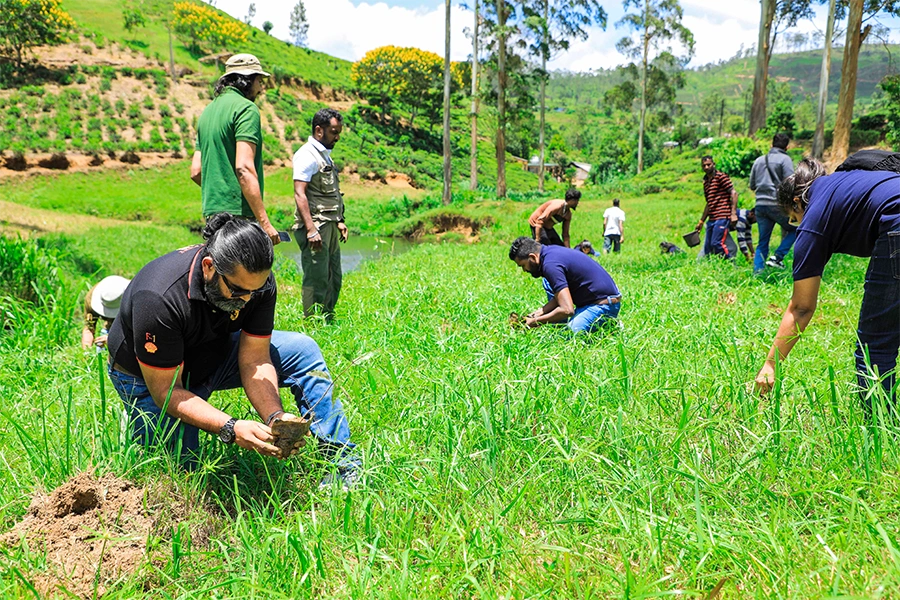
Maskeli Oya Reforestation
- Maskeli Oya Reforestation Initiative: Teejay Lanka PLC, in collaboration with the Wildlife and Nature Protection Society (WNPS) PLANT initiative, focused on reforesting degraded areas to create a 9km forest corridor along the Maskeli Oya. The project aims to stabilise riverbanks, restore the riparian ecosystem, and safeguard biodiversity along this vital tributary of the Kelani River, Sri Lanka’s fourth longest river. In 2024/25, the project planted 300 trees along the banks of the Maskeli Oya. To-date, over 2,650 trees have been planted in the Gouravilla segment, with strong engagement from surrounding local communities to ensure sustainability. Native montane forest tree species included Gal Weralu, Thel Keena, and Kenda; which also serve to protect endemic wildlife including the Sri Lanka Barbet and the Horton Plains Shrub Frog.
- Countrywide Tree Planting Campaign: Under our Abhivarah strategy, we launched a large-scale tree-planting effort in collaboration with the Sri Lanka Army and the Central Environmental Authority (CEA). The project was launched at an event held on 10 October 2024 at the Army Farm in Kohilawagurawatta. The campaign has set an ambitious target of planting 17,500 trees across Sri Lanka, in a phased approach aimed at reforestation and strengthening climate resilience. The first phase of the project included planting of over 3,500 Mango trees in Sri Lanka’s northern areas of Iranamadu and Adiyapuliyankulam, and 15,000 local Cinnamon trees in Kohilawagurawatta.


